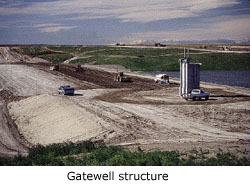
The past fifty years have seen major improvements in irrigation farming. Improvements in
on-farm
irrigation equipment and management techniques has led to increases in irrigated land base.
More
sustainable practices are being adopted by producers. Irrigation has also led to increased growth
in the
livestock industry.

The surface and sprinkler methods are the most common methods used in Western Canada. The increase in sprinkler irrigation since 1950 has been phenomenal.
With the surface method, water is applied to the soil at ground level. It flows by gravity over the
surface
of the field. When using sprinklers, water is sprayed into the air and falls to the ground like rain.
The
main advantage with sprinkler system is that it can be used on lands that are difficult or
impossible to irrigate by surface
methods. Other advantages, such as better control of water application and ease of converting
from dryland to irrigation farming, tend to compensate for the higher cost of sprinkler
irrigation. In the subsurface approach, water is applied beneath the surface, wetting the soil
surface very little, if at all.